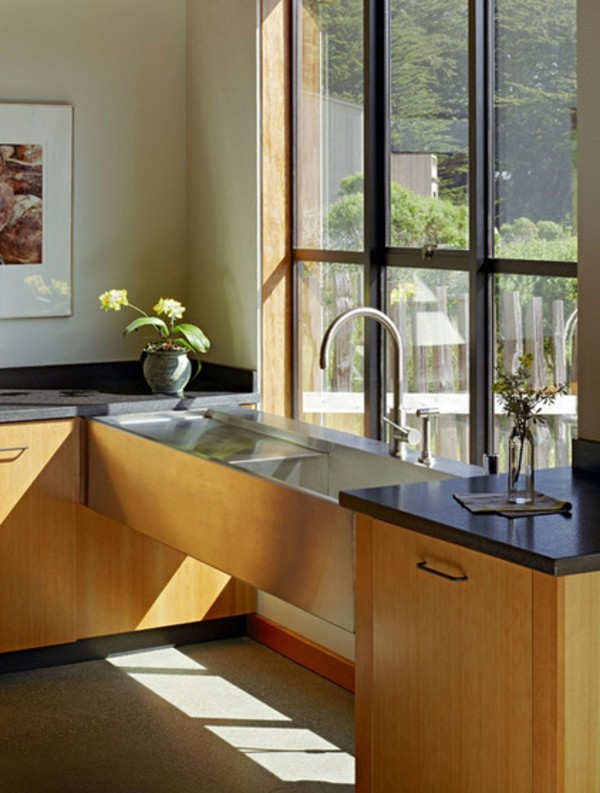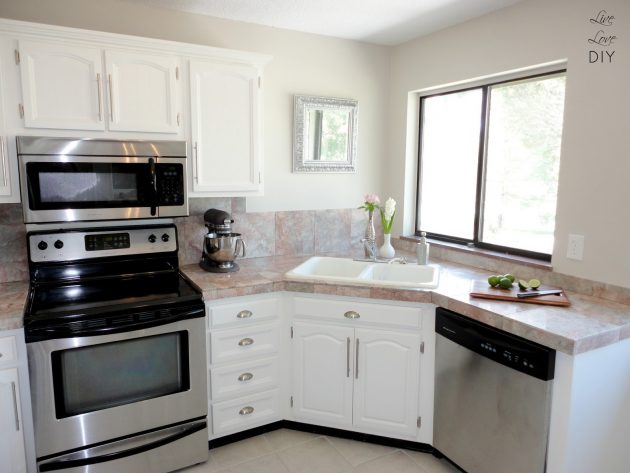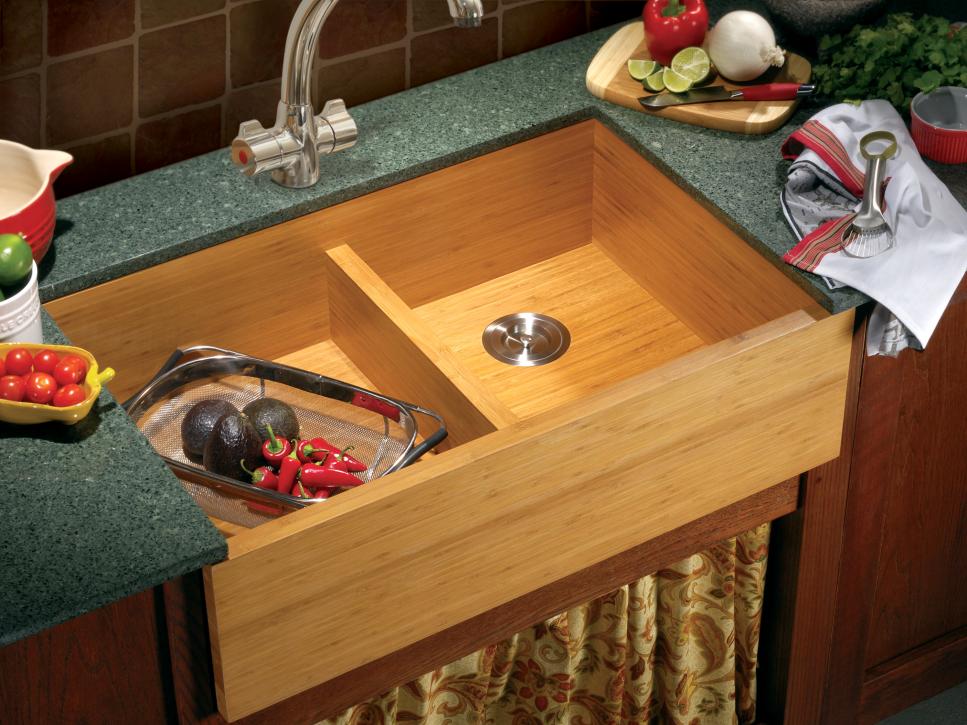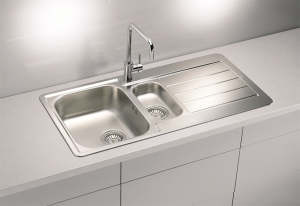When dealing with small kitchens, one of the trickiest aspects to navigate is finding a sink solution that fits both spatial and functional needs. The sink is arguably one of the most used features in the kitchen, and in smaller spaces, the challenge is to make it both practical and aesthetically pleasing. For many, a small sink feels restrictive, but with thoughtful planning and clever design, it’s possible to integrate a sink that doesn’t just fit but elevates the overall experience in a compact kitchen. The right small kitchen sink solutions are about maximizing space, improving functionality, and adding a touch of style, all without overwhelming the room.
One of the most popular solutions is to opt for a single-basin sink instead of the more traditional double-basin style. Single-basin sinks are typically more compact, taking up less counter space while still providing adequate room for washing dishes, cleaning produce, or other tasks. Despite their size, a deep single-basin sink can accommodate large pots and pans, something that is often overlooked when designing smaller kitchens. The beauty of a single-basin sink lies in its simplicity—it can be paired with a minimalist faucet, reducing clutter around the sink area while freeing up precious space on the counter.

Another smart solution for small kitchens is corner sinks. These sinks are installed in the corner of the counter, a typically underutilized area in many kitchens. By utilizing this awkward space, a corner sink can open up more room for preparation areas and storage along the countertops. Corner sinks are especially popular in galley kitchens where counter space is limited on either side. They not only make better use of space but also create a cozy and efficient workstation where everything you need is within arm’s reach.
Farmhouse or apron-front sinks are often associated with large, rustic kitchens, but they can work surprisingly well in smaller spaces. A shallow farmhouse sink can add a touch of vintage charm to a small kitchen while offering functionality that goes beyond its footprint. The exposed front of the sink extends slightly beyond the cabinetry, which can create the illusion of a larger kitchen by breaking up the visual lines. These sinks also tend to have wider openings, which can make them easier to use in smaller kitchens where maneuvering around tight spaces is more of a challenge.
A wall-mounted sink is another innovative way to save space in a small kitchen. By forgoing the traditional cabinet-mounted style, wall-mounted sinks open up the floor underneath, which can make the room feel larger and airier. This solution works particularly well in ultra-compact kitchens where every inch counts. The space beneath the sink can be used for additional storage or kept clear to maintain a more open look. Wall-mounted sinks can also be paired with compact or foldable dish racks and faucet systems to further streamline the area around the sink.
Multi-functional sinks are a modern solution that caters specifically to small spaces. These sinks come with integrated features such as cutting boards, colanders, and drying racks that fit neatly over the sink. This kind of design allows the sink area to double as a prep station, making it a space-saving powerhouse. Instead of taking up counter space with various kitchen tools, you can consolidate everything into one organized area. When you’re not using the sink for washing, the built-in accessories help it blend seamlessly into the counter, creating a cleaner, more streamlined appearance.

For those who need more workspace, a compact sink with a built-in drainboard can be a game-changer. A drainboard attached to the side of the sink provides a dedicated spot for drying dishes, draining washed vegetables, or even setting aside wet utensils. In small kitchens where every inch of counter space is precious, having this dedicated space for draining tasks ensures the rest of the counter stays clutter-free and functional. These sinks often come in narrow designs, which makes them ideal for compact kitchen setups.
If you’re willing to invest in a more unique solution, a retractable sink could be the answer. This type of sink can be hidden away when not in use, usually by sliding a countertop cover over the basin. It’s an innovative option for those who prioritize counter space but still want a fully functional sink. Retractable sinks offer a clean, uninterrupted work surface, which is especially helpful in kitchens that double as social or dining areas. They can also be equipped with extra features like retractable faucets, which further increase the flexibility of the space.
An undermount sink is another option that works well in small kitchens because it maximizes countertop space. Unlike a traditional drop-in sink, the undermount version is installed beneath the counter, making it easier to wipe down crumbs and spills straight into the sink. This design is sleek and modern, and it creates a clean, uninterrupted surface that can make a small kitchen feel more open. It also allows for larger cutting boards and prep surfaces to be placed over the sink without obstruction, which is an added benefit when counter space is limited.
For extremely tiny kitchens, consider a bar sink. These small, compact sinks are traditionally used in wet bars or secondary kitchen areas, but they can be a great option for small kitchen spaces as well. Bar sinks come in a variety of shapes and sizes, often no larger than 15 inches in diameter. They are perfect for minimal cooking needs and can be paired with a pull-out or swiveling faucet to maximize utility in a compact area. When paired with a larger primary sink in another area, they also offer great functionality for prep work or quick tasks.

Choosing the right material for your small kitchen sink can also make a big difference. Stainless steel remains one of the best choices because of its durability, ease of cleaning, and ability to reflect light, making a small space appear larger. Porcelain and composite materials offer unique styles and textures, but they may require more maintenance. Glass sinks, though unconventional, can provide a sleek and modern look that adds sophistication to a small kitchen while still being practical for daily use. The material should complement the overall design and contribute to the illusion of a larger, airier kitchen.
If you have a window over your sink, taking advantage of natural light can greatly improve the feel of the space. A sink placed under a window draws the eye outward, helping to visually expand the kitchen. If your layout doesn’t allow for a window, adding under-cabinet lighting around the sink can brighten up the area and make it feel more spacious. Lighting solutions like recessed lights or LED strips can make even the smallest of sinks feel like a centerpiece in the kitchen, adding to both the functionality and aesthetics of the room.
When it comes to faucets, a pull-out or pull-down faucet is one of the best small kitchen sink solutions. These types of faucets are compact when not in use, but they offer incredible flexibility when needed. They make it easier to wash large dishes or rinse down the entire sink area without the need for an extra sprayer attachment, which is particularly useful in small kitchens. Moreover, they come in various sleek designs that contribute to a cleaner, more modern look. Faucet designs that include touchless or motion sensor technology can also help keep the area cleaner, which is essential in a small space.

For kitchens that are tight on space, opting for a corner sink with a swivel faucet can maximize usability. This type of setup allows the faucet to be maneuvered in multiple directions, helping to clean all corners of the sink with ease. It’s an ideal choice for L-shaped or U-shaped kitchens, where counter space is limited but functionality is still a priority. The swivel faucet ensures that even in a compact sink, you can maintain the flexibility needed to perform a variety of tasks without feeling restricted.
One often overlooked solution is creating storage above or around the sink. Installing floating shelves or cabinets right above the sink area can maximize vertical space, providing much-needed storage for dishware, glasses, or cleaning supplies. This helps to keep the countertop around the sink clear, making the entire area feel less cluttered. Another idea is to install a small rod or hooks for hanging utensils and towels, which not only adds storage but also keeps frequently used items within arm’s reach.
Small kitchen sink solutions require creativity and a willingness to think outside the box. From choosing the right size and material to incorporating multi-functional features, the options for small sinks are diverse and can be tailored to fit any space or style. With the right approach, a small sink can offer the same level of functionality as its larger counterparts without compromising on design or convenience.

Common Mistakes to Avoid
One common mistake is choosing a sink that is too shallow or too small for your actual needs. While it’s tempting to opt for the smallest sink available, it can become frustrating if it doesn’t meet the demands of your cooking and cleaning tasks. It’s essential to consider both depth and basin size to ensure practicality. Another mistake is not thinking about the faucet compatibility with the sink. Some compact sinks require specific faucet designs, and a mismatch could lead to inefficient water flow or limited usability.
Neglecting storage space around the sink is another frequent oversight. Small kitchens require maximizing every inch, and failing to install shelves or hooks around the sink area can lead to unnecessary clutter on the counters. Similarly, forgetting to consider drainage needs, such as a built-in drainboard, can leave your kitchen looking disorganized and cramped.
Opting for low-quality materials to save costs is another mistake. Small sinks still need to withstand regular use, and cheaper materials may not last long or could tarnish the look of the kitchen. Lastly, overcomplicating the design with unnecessary features like multiple basins or extra attachments can make a small sink area feel cluttered and harder to use.

What size sink is best for a small kitchen?
For small kitchens, a sink that measures between 15 and 24 inches wide is typically the most practical choice. A deep single-basin sink is often ideal because it allows for larger items to be washed without taking up too much counter space. The depth should also be considered—sinks that are around 8 to 10 inches deep can provide ample space while remaining compact.
Can I install a large sink in a small kitchen?
While it’s possible to install a larger sink in a small kitchen, doing so may compromise your counter space and storage. A larger sink can overwhelm a small kitchen, making it feel cramped and cluttered. Instead, it’s better to focus on sinks designed for smaller spaces, which can still provide functionality without taking over the room. Solutions like undermount or retractable sinks can offer the feel of a larger sink without sacrificing space.
How do I make my small kitchen sink more functional?
Making a small kitchen sink more functional involves incorporating multi-purpose features. Consider sinks with built-in cutting boards, drainboards, or drying racks to maximize utility. A pull-out or pull-down faucet can also increase the flexibility of the sink, making it easier to clean and perform various tasks without needing extra space. Additionally, organizing the surrounding area with shelves or hooks for storage can improve overall functionality.

Are corner sinks a good solution for small kitchens?
Yes, corner sinks are an excellent solution for small kitchens, especially in L-shaped or U-shaped layouts. They make use of underutilized corner space, freeing up the rest of the counter for preparation and storage. Corner sinks also create an efficient work triangle, where everything is within easy reach, reducing the need to move around the kitchen frequently.
What is the best material for a small kitchen sink?
Stainless steel is one of the best materials for a small kitchen sink due to its durability, ease of cleaning, and light-reflecting qualities that can make a small space feel larger. Porcelain and composite sinks are also popular, though they may require more maintenance. Stainless steel is particularly recommended for small kitchens because it blends well with modern aesthetics and withstands heavy use.
How can lighting improve the feel of a small kitchen sink area?
Proper lighting can dramatically improve the feel of a small kitchen sink area by making it appear larger and more inviting. If you have a window over your sink, natural light can open up the space, while under-cabinet lighting can brighten dark areas around the sink. Recessed lights or LED strips can highlight the sink as a focal point, adding both function and a modern touch to the design.

Best Modular Kitchen Sinks Designs // Latest Kitchen Sinks

Small spaces: an IKEA laundry room under the stairs

What’s the right kitchen sink for your home?

Kitchen sink – Uncyclopedia, the content-free encyclopedia

Related Posts:
- 36 Inch Farmhouse Kitchen Sink
- Undermount One Bowl Kitchen Sinks
- Chrome Kitchen Sink Taps
- Kohler Kitchen Sink Drain Stopper
- Plumbing Kitchen Sink Drain Vent
- Kitchen Sink Food Strainer
- 18 Inch Undermount Kitchen Sink
- Why Is The Water Pressure Low In My Kitchen Sink
- Connecting Kitchen Sink To Drain Pipe
- Copper Double Kitchen Sink
